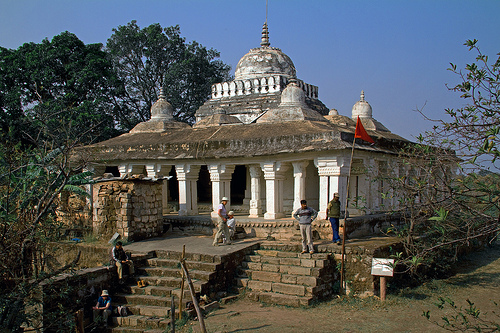

Location: Umaria District Map
Constructed: no latter than 3 century BC
Bandhavgarh Fort is an ancient hill fort located in the Umaria district of Madhya Pradesh, India, at the heart of the Bandhavgarh National Park. Perched atop Bandhavgarh Hill, which rises 811 meters above sea level, the fort dominates a landscape of rugged cliffs, dense forests, and swampy meadows known locally as 'bohera'. The fort spans approximately 560 acres of grassland plateau, surrounded by 32 smaller hills and featuring natural ramparts that provide panoramic views of the surrounding Vindhya Range. Its coordinates are around 23°40′58.96″N 81°2′7.49″E. The area is renowned not only for its historical significance but also as a biodiversity hotspot, home to a high density of Bengal tigers and other wildlife. The fort's integration with the national park makes it a unique site where history and nature converge.
The history of Bandhavgarh Fort dates back over 2,500 years, with evidence of human settlement from prehistoric times. Ancient texts like the Narad-Panch Ratra, Shiva Purana, and Akbarnama reference the fort. Legends tie it to Hindu mythology: Lord Rama is said to have gifted the fort to his brother Lakshmana to guard Lanka after defeating Ravana, naming it "Bandhavgarh" (brother's fort). Monkey architects from the Ramayana, led by Hanuman, allegedly built its impenetrable walls. Historical records begin around 300 A.D. with the Bharhivas Vakatak Dynasty under King Bhimsen, whose inscriptions remain in caves. The fort passed through dynasties including the Maghas, Sengars, Guptas, Pratiharas, Kalachuris, Rajputs, Baghels, and Kuruvanshees. The Baghels ruled until 1947, using it as a hunting reserve. In 1617, they shifted their capital to Rewa, reducing human activity and allowing the jungle to thrive. Post-independence, the fort came under government control and is now part of the tiger reserve. It remained inhabited until 1935 and is associated with figures like saint Kabir Das and musician Tansen. Man-made caves with rock paintings and inscriptions suggest settlements predating Christ.
Bandhavgarh Fort is a classic hill fort, constructed in the 10th century using local stone by a Rajput clan. It stands 2,500 feet tall with cliffs up to 240 meters, featuring huge sandstone walls, imposing gates, and intricate carvings blending various architectural styles. Inside, remnants include a treasury, prison, queen’s palace, parliament (House of Commons), school, stables, and temples. A hidden escape passage exists from one temple. The fort includes three lakes and ancient ponds vital for wildlife. Key features are the 39 caves scattered across the hill and surrounding hillocks, some dating to the 1st century with Brahmi script inscriptions. Temples include the white Bandhav-Dhish temple dedicated to Lakshmana, three 12th-century temples, and rock carvings of Vishnu's incarnations from the 10th century, such as a 32-foot reclining Vishnu at Shesh Shaiyya (where the Charanganga River originates), a 22-foot Narasimha, Varaha, Matsya, and Kurma. The fort is in a dilapidated state but retains its grandeur.
Bandhavgarh Fort holds immense historical, spiritual, and ecological significance. Spiritually, it is a site of worship with Lakshmana as the presiding deity and associations with Vishnu's preservation themes, symbolized by the cyanobacteria-rich spring pools. Historically, it represents layers of Indian dynasties and mythology. Ecologically, its abandonment allowed the area to become a premier tiger habitat, forming the core of Bandhavgarh National Park, established in 1968 and declared a tiger reserve in 1993. The park boasts the highest tiger density in India and diverse fauna including leopards, deer, and over 250 bird species. Conservation efforts focus on balancing tourism with wildlife protection; the fort's restricted access preserves its ruins and supports biodiversity. Stories of tigers coexisting peacefully with priests highlight the harmonious human-wildlife relationship.
Access to Bandhavgarh Fort is limited due to its location within the national park's Tala zone. Visitors can embark on guided jeep safaris or treks, but the full fort is currently restricted; tourists are allowed only up to the halfway point at Shesh Shaiyya to view the Vishnu statue and carvings. A knowledgeable guide is essential for interpreting the site's history and spotting wildlife en route, such as vultures, blue rock thrushes, and tigers. The trek from Chakradhara meadow offers breathtaking views and encounters with ancient sculptures nestled in the forest. Safaris combine fort exploration with tiger sightings, birdwatching, and visits to nearby attractions like Cheshpur Waterfall. Permits are required, and the best time to visit is October to June, with stays available in nearby lodges. The site appeals to history buffs, spiritual seekers, and nature enthusiasts, offering a blend of adventure and serenity.